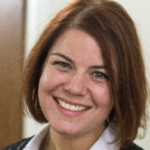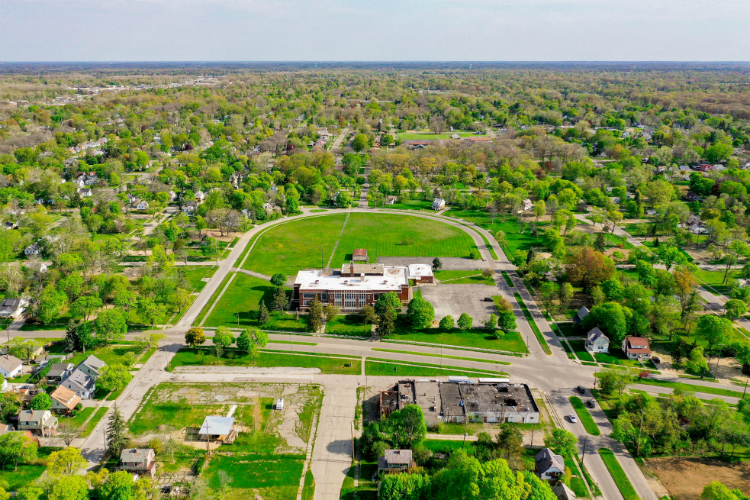
A neighborhood with a rich history, built through and decimated by inequity. A neighborhood that today is determined to create its own destiny.
FLINT, Michigan—The year is 1919. A freight train screams out of the Grand Trunk Depot every 6 minutes, 24 hours a day. It heads 20 blocks northwest carrying 2,000 tons of materials to the muddy fields where mosquitoes are especially bothersome and elderberries grow in bunches along the creek.
This is the outskirts of Flint, a booming Flint where General Motors was founded 11 years before. Soon this land will become a neighborhood. From the very beginning, though, this place called Civic Park was much more than a place to live.
It was a symbol of prosperity after the war, a flashy display of corporate strength, and a beacon for those in search of the American dream.
For some generations to come, buying a house on Chevrolet Avenue or Dupont Street meant you had succeeded at life. For some generations to come, General Motors continued to breathe life and dollars into Flint. Then it all came crashing down.
Slowly. Inevitably.
The rise and fall of Civic Park is an all too familiar tale: It is a story of great expectations that for a while overshadowed the blatant racism and economic vulnerability built into its foundation.
“To me, Flint was a social experiment that failed. It was corporation that came in here, and everybody built everything around that corporation — unknowing that if that corporation left, everything in the community dies,” says Pastor Robert McCathern, whose church sits at the corner of Dayton Street and Chevrolet Avenue.
“So, we built houses for 200,000 people based on a working scenario of this is how the plants are taking the people in. They left, and when they left, all the subsidiary companies left with them.”
But did Flint die?
“Flint died economically, but it did not die spiritually,” McCathern says.
Today, as Civic Park celebrates its centennial, it is a neighborhood filled with people working to bring stability, vitality, and families back here. It is good work, but a work filled with the inherent conflict over what was and what will be.
The beginning
Construction in Civic Park began April 12, 1919, just five months after the end of World War I. General Motors Modern Housing Corporation was under orders by soon-to-be GM President Pierre S. du Pont to complete construction of 1,000 homes by the end of the year.
Local lore often claims that Civic Park is America’s first subdivision. It isn’t, but pride runs deep here, sometimes deeper than fact.
“We very much misunderstand our local history and that is partially because it’s only been told by certain people over time,” says Thomas Henthorn, a history professor at the University of Michigan-Flint and chairman of the Civic Park Centennial Planning Committee.
There are examples across the country of other similar neighborhoods that were founded years, even decades before Civic Park. In fact, there were entire manuals showing how this type of neighborhood could be constructed, Henthorn says.
Still, there is much to be proud of in the engineering marvel that is Civic Park.
Carved out of land that used to be part of the Stockdale and Durant family farms, Civic Park quickly became home to a temporary village of construction workers. To ensure the utmost efficiency, there were five sawmills, two commissaries, a barber shop, a shoe repair stand, open air theaters, nearly 100 bunkhouses and up to 4,600 men stationed here during construction.
It was an assembly line of homes, 24 hours a day.
Because here in Civic Park, like in the factories building Buicks on Hamilton Avenue, every minute counts.
Walls were prefabricated and hauled to each lot. Then, teams of workers — carpenters, plummers, electricians, finishers — swooped in like clockwork, starting and finishing their tasks in just a few hours. Then, they moved out of the way, making room for the next team of workers, and on to the next house.
It took just seven hours to build a home.
And, they were really nice homes.
Civic Park neighborhood features consistent architecture with barn-style Dutch colonial houses and New England-esque saltbox homes. They were 1½- or 2-story houses, often with about 1,100-square-feet of space, and boosting 8-foot, 6-inch ceilings and spacious 10×10 bedrooms. They sat back from the street and homes featured open, neighborly, front porches. The 50-foot lot frontage included room for a driveway alongside the house so the homeowners could add one later — if they someday achieved that American dream, too.
And, it was all located upwind of the soot and smoke coming from the city’s manufacturing plants.
Purchase price was $3,500 to $8,000.
“The residential areas within Civic Park were planned around elements such as the school, the park, the community center and a neighborhood commercial area. For being constructed in the early 1900s, Civic Park exhibits remarkably progressive thinking,” wrote historian Joan Meister in a 1978 article published through the Michigan History Division.
But Civic Park, like so many other urban areas across America that flourished, was inherently flawed. The American dream wasn’t supposed to be for everyone. Neither was Civic Park.
Inequity was built into the very fabric of the community. Deed restriction No. 2 forbid anyone who “is not wholly of the white or caucasion race” to occupy the home. Planning a self-contained, self-sufficient Civic Park was as much about providing for its families as it was about keeping others out.
At the same time, Civic Park was nothing short of an engineering marvel of its time.
In just over eight months, a remarkable 950 homes sprung up here and families flocked to the well-constructed neighborhood — but as 1919 came to a close, the Civic Park project in all its might and glory, fueled by the highest in GM brass, failed to reach its goal. On Jan. 1, 1920, construction ended, 50 houses short of the target.
Today, that same ambiguity over what is success and what is failure taunts Civic Park. There is undeniably a sense of loss here that thrives in the tension created by the grand hopes and dreams of its residents and the reality of small, incremental change.
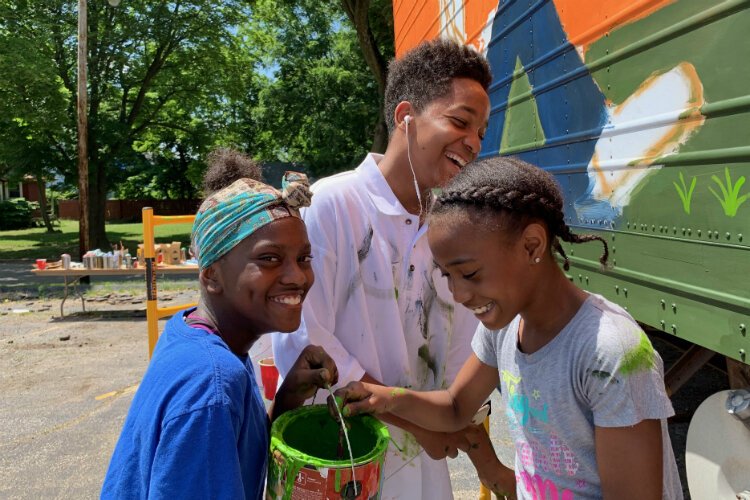
Seeing change
About the same time Civic Park construction was getting underway, the matriarch of the Vaughn family of Georgia moved, perhaps fled, to Flint after her husband was killed. A mother of 11, she came to Flint presumably because some of her older children already had relocated here.
It’s the story of Lynn Williams’ great-grandmother and her family’s journey to Flint, passed down through the generations. Williams lives in Civic Park, in the home that once was her mother’s home.
The family ended up here under what Williams, now three generations later, still sees as questionable circumstances.
Officially, Williams’ great-grandfather — a landowner in Greenville, Ga. — was killed in a hunting accident. However, his death coincided with a time when a railroad company was looking to build in the area. When Lynn Williams tells the family story, she motions with her hands, putting air quotes around the words “hunting accident.”
Her grandmother would go on to lose the land, and when Williams returned, generations later, she saw the railroad tracks cutting through her former family homestead.
“That unfortunately is not a unique story for many of the African-American families that moved to Flint,” Williams says.
Lynn had just graduated from Flint Northern a few months prior when she and her mom moved to the unique Civic Park home in Lot 30, Block 30 of the Civic Park Addition on Labor Day Weekend 1979.
They moved into the white two story — built about 18 years after those first 950 homes in Civic Park neighborhood, but which could easily be mistaken for a mid-century modern — because her brother was in real estate and came across the one-of-a-kind home.
“When we moved here, the neighborhood was very populated. I don’t think there was any vacancies. There were a lot of families,” says Williams, an active member of the recently reconstituted Civic Park Neighborhood Association. “It was a diverse neighborhood at that time as well. It was active; there was a lot of activity around. There was neighborliness.”
Williams worked in the neighborhood branch of the Flint Public Library located inside Civic Park Elementary School. She would walk her nephew to school and neighbors would have bonfires and get-togethers.
Civic Park was different.
Williams saw other neighborhoods in Flint swiftly reject diversity. Even while Flint made headlines for its landmark 1968 fair housing ordinance — unique because it was approved by popular vote — Williams saw that in reality, the city remained starkly divided.
Williams watched as all-white neighborhoods transitioned, sometimes within just a year or two, to being entirely black once that first family of color broke the racial barrier. Over the next decade, the same scenario played out throughout Flint’s north side. Eventually, saying “north of the Flint River” became code for being black.
Except Civic Park.
Diversity — or at least a slight nod to integration — lasted longer here. The neighborhood also has been highlighted as a case study in redlining, but for a few years, years that Williams experienced, there were black and white neighbors within the thriving neighborhood.
The city overall continued to face challenges as poverty, crime, and drugs became more and more prevalent. Then, the white neighbors started leaving.
“Once it started, that seemed like it was overnight,” Williams says.
The American Dream
Civic Park was envisioned by the elite industrialists of the time years before construction even began in 1919. “They were considered progressive, but they were also very much men of their time,” Henthorn says.
And, their time — when Civic Park was built — is perhaps the most relevant and often overlooked piece of motivation behind the construction of Civic Park.
Henthorn notes the property on which Civic Park was built was officially sold on Nov. 11, 1918, the very day the armistice was signed ending World War I.
“People can kind of see the end of the war coming and realizing this is going to work out OK,” says Henthorn, who’s research is also being used for an upcoming academic article on Civic Park. “During wartime people are already doing post-war planning. GM is anticipating a post-war boom. There is a speculative frenzy.”
And, that also raised concern among the commercial and civic elite who wanted to “craft the city into a certain kind of image of what a city should look like,” Henthorn says.
That included maintaining segregation based on race and class — Civic Park was actually only affordable to highly skilled workers, not the entry-level hourly workers who faced a housing shortage. It included ensuring homes were built, instead of shacks without running water that were favored by get-rich-quick speculators.
It included what Henthorn calls “welfare capitalism” designed to keep workers loyal to and dependent on their employers — and keep unions away. It provided a wide array of service to and support for workers and Flint. It built neighborhoods like Civic Park (followed by Mott Park and Chevrolet Park), gave rise to social groups including Industrial Mutual Association, provided loans, built parks, constructed community centers, and developed Flint into a thriving central hub.
And, until late in the Great Depression and the Sit-Down Strike of 1936-37, welfare capitalism worked and it worked its way into the fabric of the community.
“Flint is really kind of starting to create this civic identity about it. This is an auto town where the middle class is accessible and where if you worked hard you could have the American Dream,” Henthorn says.
The identity was defined — and more broadly the fulfillment of the American dream — was defined as this opportunity that in reality only existed for white men, Henthorn says.
“We are still stuck in that identity,” Henthorn says.
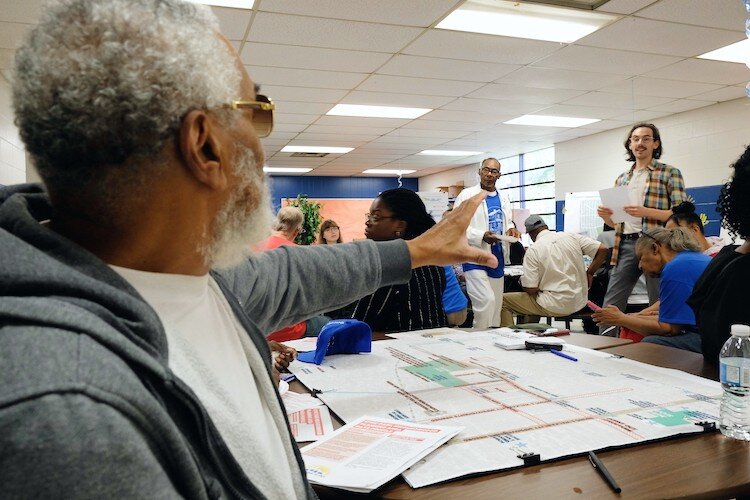
The biggest loss
Dan Kildee’s family moved to Civic Park in 1962 when he was just 4 years old. He grew up in the two-story, modified A-frame home on West Genesee Street during the heyday of community education.
“We were centered around Civic Park School and Haskell Community Center and Bassett Park. There was always something going on. All summer long, afterschool, everyday, on the weekends, there was something to do,” Kildee says.
The abundance of activity was also borne of the sheer number of other families around. There were 48 children on his block between Trumbull Drive and Brownell Boulevard, and that block, “That was my whole world,” Kildee recalls.
His father, Jack Kildee, worked in electrical supply. His mother stayed home and cared for their six children and any other friends they brought home.
Jack Kildee grew up in Flint attending school and Mass at St. Mary’s on Franklin Avenue, before joining the U.S. Navy in 1950. He served on a destroyer used for minesweeping after World War II. When he returned home, be began what would be a 46-year career in electrical supply.
Jack Kildee was about seven years into his career when the family moved to the 1,597-square-foot home with four bedrooms and two baths.
“We were moving to the westside and for my dad especially, growing up being an eastsider, that was like he’d arrived,” Kildee says. “It was this sense that we were living really what we thought the American dream was.”
Dan Kildee was still living at 1901 W. Genesee when he first won public office, elected in a citywide election to the Flint Board of Education at 18 years old. It was 1977 and he wore a blue dashiki to his swearing-in.
He moved out later that year and started college. His parents and his younger siblings moved out about five or six years later, relocating to Flushing.
Now, 42 years later, Dan Kildee is a congressman serving Michigan’s 5th District. Although only in his fourth term, he serves as a leader among House Democrats as both a chief deputy whip and a member of the powerful Ways and Means Committee.
He rose to national prominence both as a Democratic political operative for the state of Michigan and for his leadership in tackling urban issues including depopulation and the glut of vacant houses left in its wake.
As County Treasurer he developed the first land bank in the state of Michigan and went on to found the Center for Community Progress, a nonprofit focused on revitalization of American cities.
Sitting in his Flint office on an upper floor of the Dryden Building in bustling downtown, Kildee still proudly calls himself a “Civic Parker.”
He noticeably tenses at a suggestion that those days gone by for Civic Park or even the country were better than today, despite his own positive childhood memories.
“It’s one of the values of being a little bit older and having some ability to think back. Nostalgia for the old days is only good if you were experiencing good times then — and not everybody had that benefit,” Kildee says.
Civic Park’s deep-rooted problems are evidenced even in his own childhood home.
The house is still there, but vacant and crumbling. Last time Kildee visited, it sat open, holes in the exterior. Upstairs, the rooms were strewn with trash. In 2015, the Genesee County Land Bank took ownership of the home. Later that same year, Jack Kildee died.
And, yet, Dan Kildee could also see familiar cracks in the sidewalks, just bigger. The oak tree next door was still there, just looming even larger. The memories came flooding back.
It was the same house, but everything had changed.
Next door are two vacant lots. There are five in all on this block now, empty green spaces where homes used to be. Four still-standing homes, including the Kildee homestead, are vacant.
“The physical elements of the neighborhood have deteriorated, but that’s probably not the biggest loss. It’s all the other aspects of community,” Kildee says.
The crash
In 1979, General Motors reached its U.S. employment peak with about 80,000 GM workers in Flint. That very year Civic Park won elite status and was listed in the National Register of Historic Places.
Then, half a world away, the Iranian Revolution ousted a longtime American ally and ushered in the second oil crisis of the decade in America. It led to another spike in inflation, a U.S. recession in the early 1980s, and plummeting auto sales.
Michigan crashed. Flint crashed even harder. And Civic Park became a shell of what it once was.
Jobs left. Workers left.
“This neighborhood was built to house workers at General Motors,” Williams says. “That’s the reason for it. People have to move. Without that income, there are no working families to live here.”
There was a desperate attempt to hold on to everything that Civic Park was. In 1981, the City of Flint issued its “Home Preservation Manual” for Civic Park detailing how homes could be renovated, types of materials that could be used, paint colors, etc.
“This recognition confirms the belief that Civic Park is an important part of not only Flint and Michigan’s history, but of our nation’s history. Civic Park is worth preserving,” it reads.
The economic woes were complicated by the rapid growth of illegal drugs, especially crack cocaine in the early and mid-’80s. And, all the while, Flint continued to see more and more manufacturing jobs go away.
It devastated families, forcing them to move to elsewhere in search of opportunity. And, Henthorn notes, it devastated the community which was losing its whole identity.
Flint is the birthplace of General Motors and the UAW. Flint gave rise to the Middle Class. Flint is Vehicle City.
Except it wasn’t anymore.
There was one last, big push in the 1980s to hang on to this civic identity through a renewed focus in automotive heritage, including, of course, AutoWorld, Henthorn says. Billing itself as “the largest indoor theme park in the world,” AutoWorld opened July 4, 1984. In six months, it closed (although there were occasional temporary efforts to breathe new life into it for nearly a decade).
“When AutoWorld goes belly up, you can see the interest in preservation change dramatically,” Henthorn says.
From 1970 to 1980, Flint population declined by more than 30,000, the first major population loss the city had seen. From 1980 to 1990, population went down another 20,000, bringing it below 150,000 for the first time since the 1920s.
Flint was spiraling.
Residents, angry, went to City Council for help. Some formed crime watches. Others installed exterior lighting.
A Flint Journal article from April 16, 1985, describes the scene at a City of Flint budget hearing held at Haskell Community Center: “Flint City councilmen were deluged with complaints about dope houses, the lack of housing code enforcement and road repairs from residents.”
Over the years, more and more houses became rentals. Then, hundreds of them were simply abandoned, left rotting. The blight spread. Civic Park School, built to be the heart of the neighborhood, closed in 2010.
For 30 years, Civic Park simply continued to decay.
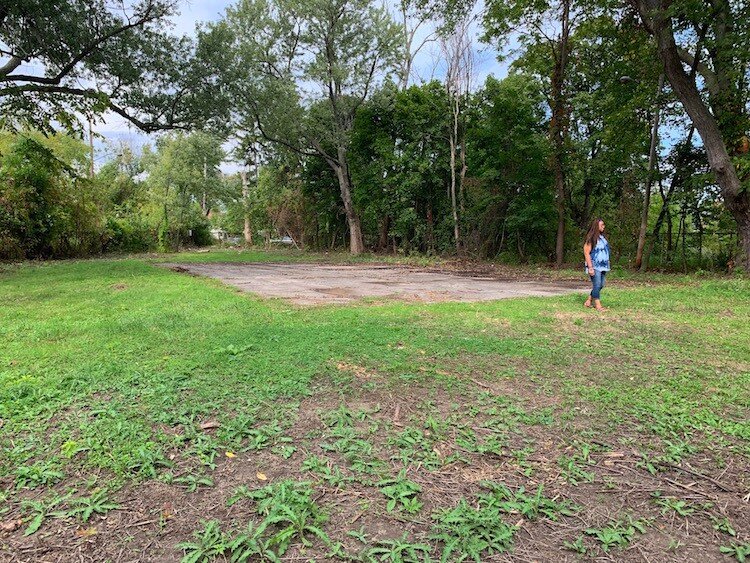
But God
“It was a very dangerous neighborhood when we got here,” says McCathern, whose Joy Tabernacle church is located at the site of Civic Park’s first church — originally called Community Church and later Community Presbyterian Church. “There were thousands of abandoned houses. We would ask: ‘What are your plans?’”
“We have no plans for your area,” McCathern recalls being told.
But God, McCathern says, God always has plans.
McCathern had come to Flint to visit family and never left, founding Joy Tabernacle in 2001 inside the former YWCA building in downtown Flint. It started as a small Bible study group — a nondenominational “fellowship of Christian believers” — and grew slowly over time. Services were Thursday nights and Sunday mornings and McCathern baptised new believers in the Y’s basement swimming pool.
“I’ve always had a connectedness to God in terms of assignments,” McCathern says. “All of my life, usually when I get things planted, he uproots me to another location and another ministry. When I got here, he said: ‘You don’t have to go this time.’ I’m old enough this time now, not to uproot again. This is my final work, my final contribution to humanity.”
The church grew to about 60 members before beginning its quest for a permanent home. It took years and nothing short of a miracle, McCathern says, for them to find their home inside the historic church at the corner of Dayton Street and Chevrolet Avenue.
The Community Presbeteryan Church had boasted as many as 1,600 members back in the day, but those days were long forgotten by 2008 when its dwindling membership decided it would close its doors.
Registered as a state historic place, the church was an outgrowth of the rush of families into the Civic Park neighborhood. Several Presbyterian families first met in 1919 for a Christmas party and by 1921, they formally came together as a Presbyterian Church.
The basement — where services are now housed — was completed in 1924 and the sanctuary was built in 1927. According to the neighborhood’s nomination to the National Historic Register, it was the neighborhood’s first church and welcomed people of all faiths.
And, so does Joy Tabernacle today.
On Oct. 11, 2009, Joy Tabernacle purchased the church for $15,000, far less than the asking price and with the blessing of the Community Presbyterian Church members who opted to lower the price so that the new church would not be saddled with any debt.
With a bit of premonition (or perhaps divine insight), McCathern says then: “I knew that this was the place that God was going to do the greatest work in my life. I felt connected so richly to spirit of church. To me, we’re one church.”
First, he focused his work on the neighborhood and its plague of abandoned houses.
“I thought it was so wrong when children were walking to the schools. This is their America,” McCathern says. “I thought it was so wrong when people who retired from General Motors, who did everything right … had to sit across and look at five abandoned, exposed houses.”
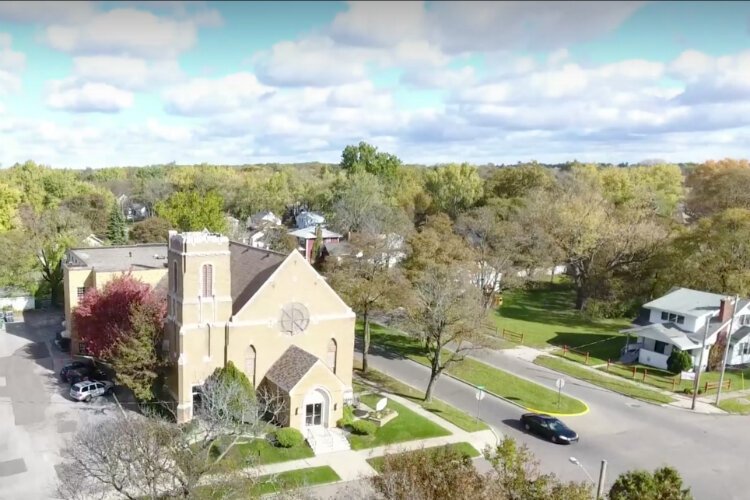
Changing landscape
Abandoned houses are, but even more so were, a major issue for the neighborhood. Now there are fewer abandoned houses, but more vacant lots — scattered swaths of flat, green spaces where family homes once were.
Civic Park was added to the National Register of Historic Places in 1979. Intended to be a bold move to ensure the neighborhood’s preservation, many who live here now see it as unwittingly helping to speed its decline because of the intense regulation of the historic district as outlined in the 125-page “Home Preservation Manual.”
In 2013, the Genesee County Land Bank received a massive $20-million grant to demolish properties from the Hardest Hit Fund through the U.S. Department of Treasury — except Civic Park and its blighted, abandoned properties couldn’t be included because historic districts were specifically excluded.
However, $10 million was up for grabs at the state — but the historic district designation remained an issue because of the protections it put over the homes.
Work began so that the neighborhood could become decertified, a move that became the launch pad for the single most transformative thing to happen in Civic Park in at least a generation.
The discussion inspired property assessments and statistics on the vast amount of deterioration, conversations about potential new development and big dreams for the future.
Most importantly, there were community conversations. For the first time in a long time, the people of Civic Park came together.
Ultimately, the neighborhood weighed in somewhat unexpectedly and in overwhelming agreement told the Michigan State Historic Preservation office that they wanted both — to be a historic neighborhood and to remove the preservation requirement standing in the way of blight removal.
They got their wish and, less than a year later, the Genesee County Land Bank was awarded $2.6 million to remove 225 blighted homes in Civic Park.
And, as the blighted homes came down — the overall image of Civic Park improved. In 2012, just half the homes were rated in “good” condition, but by 2018, 67 percent were in “good” condition, according to a community dashboard compiled by the Ruth Mott Foundation.
Even as the percentage of houses in good condition declined across the entire city and especially in north Flint, Civic Park defied the trend and saw its housing stock improve.
Today, there have been more than 550 demolitions in the Civic Park neighborhood, which the city defines as larger than the historic district boundary (stretching five additional blocks west and at least two blocks north).
Put simply, one-third of all properties are vacant. And there will be more.
At first, Williams enthusiastically greeted demolitions. She still sees them as necessary, but more reluctantly so. Now, she wants to see more dollars going to preserve the neighborhood.
The two houses next door to her are vacant. They have been for years. She still holds hope that maybe one of them can be restored.
“If there were resources that could help to preserve at this point and move forward, that would be great, because we don’t want to totally lose the community,” Williams says.
Civic Park, and Flint for that matter, aren’t unique in their industrial boom and bust, history of segregation and redlining, or their grand belief and disappointment in the American Dream.
There’s Kodak in Rochester, NY. The steel industry in Pittsburg. The stockyards and railroads in Kansas City.
“Any close look at the history of civilization, generally, you know there are periods of growth followed by periods of decline,” Kildee says. “The fundamental American sense was that it would always keep growing — it would just continually expand — and, of course, we know that’s not the case.”
Housing is the most obvious artifact of that belief.
“It’s a hard path forward. Really hard,” Kildee says. “I think it starts with the hard choices of clearing away the reminders of past failure that can’t be restored.”

The future
Pastor McCathern is pacing, excitedly. He clearly has the spirit.
He’s walking back and forth across the same space that a few days ago hosted the monthly food giveaway. He is physically unable to stop moving.
“This. This is — This is bigger than us. No human could do all this. This is God,” McCathern says, still reeling with excitement from the last Ubuntu Village planning meeting.
The purpose of Ubuntu Village is to rebuild what was lost — to rebuild community and togetherness in the Civic Park neighborhood and among its people. The village is inspired by the African proverb and philosophy often translated as “I am because we are.”
A project of the Urban Renaissance Center, which operates out of Joy Tabernacle with McCathern serving as its executive director, Ubuntu Village’s next step is for the concept to move beyond the Urban Renaissance Center and the many programs it runs — to become, simply, the way of life.
There is a quote that is one of McCathern’s favorites. It guides his work and he will, even in casual conversation, stop to recite it verbatim:
“He drew a circle that shut me out—
Heretic, rebel, a thing to flout.
But love and I had the wit to win:
We drew a circle and took him In!”
Published in 1915 by American Poet Edwin Markham, it dates back as far as Civic Park itself and is the reason behind so much of what happens here.
It is nearly impossible to actually keep track of all the different activities, all designed to bring people in. There is the music studio upstairs, the Mr. Gaines garden around the corner, the job training for formerly incarcerated, a computer lab, Claressa Shields Community Project and its free summer camp for kids, water distributions, food distributions.
But, it’s about more than Joy Tabernacle.
St. Luke’s NEW Life Center on the northernmost edge of Civic Park is another massive operation with job training, life skills, food and clothing — all designed to invest in the neighborhood.
There’s the gospel festival organized by the Civic Park Neighborhood Association and the three-day Heritage and Harmony festival organized by Councilman Maurice Davis and his Civic Park Business District Association.
Civic Park is the only neighborhood outside of downtown that hosts its own Christmas tree lighting ceremony — plus there is the weekly walking group and classes on mindfulness.
“Of all the places I’ve been worldwide, this place has a spark here,” McCathern says.
There is a distinct feeling throughout Civic Park that its history is being written again, its community being built again.
The Ruth Mott Foundation alone has invested more than $1.2 million directly into the Civic Park neighborhood in the last three years. Another $500,000 came from the Charles Stewart Mott Foundation.
Both also have given hundreds of thousands in other grants that also benefited Civic Park as part of broader funding strategies — and a wide variety of other organizations also have planted seeds of hope here. The American Heart Association issued a $100,000 grant from its Social Impact Fund and Convoy of Hope recently announced it would partner with the Urban Renaissance Center to develop one of the city’s largest urban farms in Civic Park.
And, Civic Park has its people — its passionate advocates who want more than to remember days gone by.
Yes, Williams says, she wants people to know the great history of Civic Park. Yes, she wants people to know it is wrong what happened to her neighborhood and so many others.
But, she also wants you to know that this neighborhood is filled with strong, hard-working people who are fighting and will continue to fight for the great future their neighborhood deserves.
“I still live here because it’s the heart of Flint to me. I just want to stay here as long as I am in Flint,” Williams says. “We may be a very different neighborhood from where it started — but still a strong neighborhood with a lot of civic pride.”

This story was developed with support from Images and Voices of Hope as part of the Restorative Journalism Fellowship program. It is part of Flintside’s On the Ground coverage in Civic Park, a six-month intensive neighborhood journalism project supported by the Ruth Mott Foundation and Community Foundation of Greater Flint.

